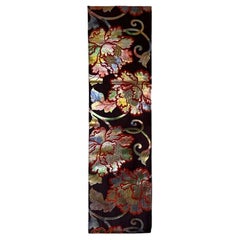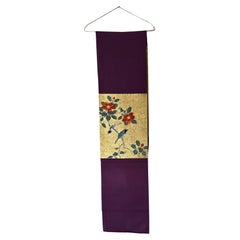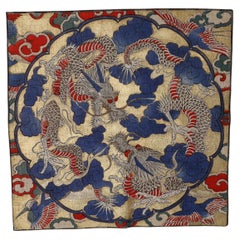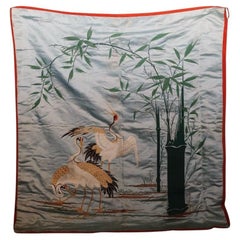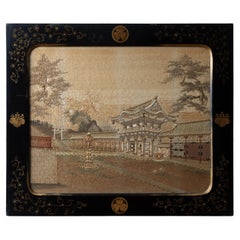Japanese Textiles
to
11
122
14
153
25
1
23
1
1
3
55
95
26
53
25
2
5
1
4
1
2
1
173
94
39
33
32
13,937
1,328
462
443
432
179
176
179
3
Place of Origin: Japanese
Japanese Silk Obi/Table Runner/Wall decoration with Peony Motif
Located in Fukuoka, JP
apanese Silk Obi Table Runner with Peony Motif
Japan, 20th century
Dimensions: 440 × 32 cm
This luxurious silk obi has been repurposed into an elegant table runner. Woven with shimm...
Category
20th Century Showa Japanese Textiles
Materials
Silk
Antique Japanese Obi Textile Panel with Birds and Camellia Flowers, Meiji Period
Located in Fukuoka, JP
A magnificent antique Japanese silk obi fragment from the Meiji period (1868–1912), showcasing exceptional hand embroidery and gold leaf overlay.
This refined textile features a pai...
Category
19th Century Meiji Antique Japanese Textiles
Materials
Silk
Meiji Period Golden Dragon Zabuton Covers by Tanaka Rishichi
Located in Fukuoka, JP
The unique batik zabuton covers are adorned with golden dragons and are believed to have been originally ordered for a temple. The cushion covers were made under the Tanaka Rishichi ...
Category
19th Century Meiji Antique Japanese Textiles
Materials
Linen
Silk Brocade Japanese Kimono Ceremonial Gown
Located in Vienna, AT
Japanese kimono, richly decorated with polychrome embroideries with silk and metallic threading, bright red silk set, embroidered decoration and appliqué, motif of flowers and horses...
Category
1920s Showa Vintage Japanese Textiles
Materials
Silk
19th century silk decorative pillow case (Fukusa)
Located in Fukuoka, JP
Superb embroidered silk Fukusa, wedding gift wrapping silk cloth decorated with auspicious motive.
Condition : Fine original condition with only minor abrasions and very ...
Category
19th Century Edo Antique Japanese Textiles
Materials
Silk
Japanese Silk Embroidery in Lacquer Frame, c.1890
Located in Savannah, GA
A Japanese export silk embroidery of a Shinto shrine in original parcel gilt ebonized lacquer frame, circa 1890.
29 ¼ by 24 ¾ inches
Category
Late 19th Century Meiji Antique Japanese Textiles
Materials
Silk, Glass, Wood, Lacquer
Framed Japanese Embroidery Textile Panel Meiji Period
Located in Atlanta, GA
A Japanese textile panel with embroidered picture work circa late Meiji period (1900s) presented in a gilt wood frame with silk mat. The work de...
Category
Early 1900s Meiji Antique Japanese Textiles
Materials
Silk, Wood
sky color bird by Blue Tip Atelier
Located in Sammu-shi, Chiba
Title : sky color bird
Japan / 2024s
Size : w1620 x h1635 mm
Scraps of fabric used in the Sky series are used to express birds in the colours of the sky.
The materials used are li...
Category
2010s Modern Japanese Textiles
Materials
Linen
Japanese Indigo Antique Boro Futon Cover or Wall Panel
Located in Alessandria, Piemonte
Rare perfect antique collection Japanese Indigo Boro Futon cover : also to use.
The rare antique boros are now valued as pieces of art, therefore they are...
Category
Mid-20th Century Japonisme Japanese Textiles
Materials
Cotton
$2,457 Sale Price
35% Off
Japanese Asian Framed Meiji Peroid Silk Floral Flower Embroidery Textile Panel
Located in Studio City, CA
A beautiful and wonderfully designed/composed Japanese textile panel with embroidery floral natural landscape/flower decoration. The work is pr...
Category
19th Century Meiji Antique Japanese Textiles
Materials
Textile, Silk, Wood
Old Japanese Kimono / 1912-1945 / Wall Hanging Decoration / Tapestry
Located in Sammu-shi, Chiba
I think this is a kimono woven from the Taisho era to the early Showa era (1912-1945) in Japan.
It is a modern design.
In the Taisho era, various things were made with reference to...
Category
Early 20th Century Taisho Japanese Textiles
Materials
Cotton
Komorebi(Ohara, Kyoto) by Blue Tip Atelier
Located in Sammu-shi, Chiba
Title : Komorebi(Ohara, Kyoto)
Japan / 2024s
Size : w970 x h960 mm
A landscape seen in Ohara, Kyoto.
The sunlight filtering through the trees is expressed using a variety of techni...
Category
2010s Modern Japanese Textiles
Materials
Linen
Vintage Japanese Floral Silk Damask Fabric - Pearl Gray - 100% Silk - C.1950's
Located in Chatham, ON
Vintage Japanese floral silk damask fabric - pearl gray color - heavy weight with distinctive slub throughout - fine designer quality - 100% silk - suitable for crafts/pillows/light upholstery/dressmaking - circa 1950's.
Good vintage condition - raw edges - folds and creases...
Category
Mid-20th Century Anglo-Japanese Japanese Textiles
Materials
Silk
The sky visible at Honmonji Temple Ⅱ by Blue Tip Atelier
Located in Sammu-shi, Chiba
Title : The sky visible at Honmonji Temple Ⅱ
Japan / 2024s
Size : w1805 x h1805 mm
The sky can be seen from Honmonji Temple, which the artist passes while running, a hobby of hers....
Category
2010s Modern Japanese Textiles
Materials
Linen
Burgundy landscape by Blue Tip Atelier
Located in Sammu-shi, Chiba
Title : Burgundy landscape
Japan / 2024s
Size : w1460 x h1050 mm
The scenery seen from the train window while traveling in Burgundy.
The material is linen viella with a natural lus...
Category
2010s Modern Japanese Textiles
Materials
Linen
The sky visible at Honmonji Temple Ⅲ by Blue Tip Atelier
Located in Sammu-shi, Chiba
Title : The sky visible at Honmonji Temple Ⅲ
Japan / 2024s
Size : w1620 x h1630 mm
The sky can be seen from Honmonji Temple, which the artist passes while running, a hobby of her...
Category
2010s Modern Japanese Textiles
Materials
Linen
Landscape Ⅲ by Blue Tip Atelier
Located in Sammu-shi, Chiba
Title : Landscape III
Japan / 2024s
Size : W 560 H 680mm
The night sky and sea are expressed with two-tone dyed colors.
Abstract embroidery of a bird flapping its wings is applied ...
Category
2010s Modern Japanese Textiles
Materials
Linen
Leaf Ⅰ by Blue Tip Atelier
Located in Sammu-shi, Chiba
Title : Leaf Ⅰ
Japan / 2024s
Size : w 580 × h 580 mm
The green leaves of spring are expressed through dyeing, quilting and embroidery.
Also, the embroidery thread is used to express...
Category
2010s Modern Japanese Textiles
Materials
Linen
Rinne by Blue Tip Atelier
Located in Sammu-shi, Chiba
Title : Rinne
Japan / 2024s
Size : w2880 x h1960 mm
When the leaves fall to the ground, they gradually break down and mix with the soil as they rot, turning it into nutritious soi...
Category
2010s Modern Japanese Textiles
Materials
Linen
Framed Antique Japanese Embroidery Fukusa Textile Panel
Located in Atlanta, GA
A Japanese silk Fukusa Panel housed in a gilt frame circa late 19th century of Meiji Period. Fukusa is a traditional Japanese textile art used as a wrap for presenting gifts at important occasions. On the deep blue background, the elaborate embroidery work depicts a historical scene where street vendors selling goods to a royal household or an aristocratic residence. The scene focuses on the activities at the front gate where the couriers and servants were busying carrying the goods in. A peasant with straw coat...
Category
Late 19th Century Meiji Antique Japanese Textiles
Materials
Silk, Wood
Framed Antique Japanese Silk Embroidery Fukusa Textile Panel
Located in Atlanta, GA
A Japanese Fukusa Panel with tassels displayed in a gilt frame circa Meiji Period. Fukusa is a traditional Japanese textile art used as a...
Category
Late 19th Century Meiji Antique Japanese Textiles
Materials
Silk, Wood
Flamingo by Blue Tip Atelier
Located in Sammu-shi, Chiba
Title : Flamingo
Japan / 2024s
Size : w 730 × h 1800 mm
The material is fine French linen.
Hand quilted and decorated using dyed sashiko thread.
Natural dyes are chinese sumac, madd...
Category
2010s Modern Japanese Textiles
Materials
Linen
Blueberry by Blue Tip Atelier
Located in Sammu-shi, Chiba
Title : Blueberry
Japan / 2024s
Size : w 700 × h 570 mm
Blueberries displayed at home.
The material is fine French linen.
Hand quilted with cotton thread.
Natural dyes are chinese s...
Category
2010s Modern Japanese Textiles
Materials
Linen
Lumière douce (à Paris) by Blue Tip Atelier
Located in Sammu-shi, Chiba
Title : Lumière douce (à Paris)
Japan / 2024s
Size : w1500 x h1490 mm
The soft light that shines through the cloudy skies of Paris, where the artist once lived, is replaced with ...
Category
2010s Modern Japanese Textiles
Materials
Linen
Japanese Sashiko-stitched Cotton Rodogi Work Coat, Early 20th Century
Located in Point Richmond, CA
Sashiko-stitched cotton Rodogi work coat, early 20th century, Yamagata Prefecture, Japan
A full length coat composed of indigo-dyed cotton with vertical bands of sashiko stitching w...
Category
20th Century Meiji Japanese Textiles
Materials
Cotton
$1,400 Sale Price
20% Off
Vintage Japanese Obi, abstract wave pattern gold on white
Located in Point Richmond, CA
Vintage Japanese Obi. Gold kinran abstract wave pattern on a diagonal white on white brocade ground, continuous on one side, center section lined on the reverse side.
Minor signs of...
Category
Late 20th Century Taisho Japanese Textiles
Materials
Metallic Thread
Saki-Ori Farmers Coat, Northern Japan, Meiji Period
Located in Point Richmond, CA
Saki-ori farmers coat, Northern Japan, Meiji period
A very heavy and substantial saki-ori coat, made of cotton with an indigo kasuri lapel. Several patches of hand sewn stitching ...
Category
20th Century Meiji Japanese Textiles
Materials
Cotton
Japanese Oshie Pressed Textile Samurai Framed Showa Shadow Puppet Doll
Located in Studio City, CA
A wonderful, handcrafted work of a regal Japanese samurai/warrior doll shadow puppet.
Oshie, which translates as pressed pictures, is a traditional Ja...
Category
Mid-20th Century Showa Japanese Textiles
Materials
Textile, Linen, Acrylic, Wood, Paper
Framed Japanese Oshi-E Textile Art Meiji Period from a Rare Large Set
Located in Atlanta, GA
On offer is the last one of the set of seven framed Japanese textile art called Oshi-E circa Meiji Period (1868-1912). This rare set consists ...
Category
1890s Japonisme Antique Japanese Textiles
Materials
Silk, Giltwood
Japanese Asian Oshie Pressed Textile Old Monk Framed Shadow Puppet Doll
Located in Studio City, CA
A wonderful, handcrafted work of a Japanese monk/ old man doll shadow puppet who appears to be making an offering of some sort.
Oshie, which translat...
Category
Mid-20th Century Showa Japanese Textiles
Materials
Textile, Linen, Acrylic, Wood
Japanese Persimmon-Dyed Noren with Floral Motif, Taisho Period, 1910s
Located in Edogawa-ku Tokyo, JP
A charming small-scale Japanese noren (traditional fabric divider), hand-dyed using natural persimmon tannin, dating to the Taisho period. This textile piece features a delicate whi...
Category
Early 20th Century Japanese Textiles
Materials
Fabric
Rare Japanese Fireman's Four-Piece Assemble Meiji to Showa Period
Located in Atlanta, GA
A rare four-piece Japanese Fireman's assemble (Shobosho uniform) woven with heavy cotton and decorated with stencil resist dye circa 1890-20s Late Meiji to Showa Period. The assemble...
Category
1920s Meiji Vintage Japanese Textiles
Materials
Cotton
Vintage Japanese Indigo Folk Kamon Textile
Located in Chicago, IL
Dating to the mid-20th century, this vintage Japanese textile is a folk example of traditional stencil dyed fabric, known as katazome. Richly...
Category
Mid-20th Century Japanese Textiles
Materials
Cotton
Japanese Silk Thread Wood Winder Complete with Spool and Functioning Gears
Located in Point Richmond, CA
Japanese silk thread wood winder complete with spool and functioning gears. The spool still has the silk thread and an extra spool with different color thread comes with it. The thre...
Category
Late 19th Century Edo Antique Japanese Textiles
Materials
Wood, Hardwood
$1,313 Sale Price
24% Off
Framed Antique Japanese Embroidery Fukusa Panel
Located in Atlanta, GA
A finely embroidered Japanese silk Fukusa panel presented in a beautiful brocade-wrapped fame. Circa late 19th century of Meiji Period, Fukusa is a traditional Japanese textile...
Category
Late 19th Century Meiji Antique Japanese Textiles
Materials
Silk, Wood
Japanese Indigo Kasuri Ikat Traveling Cape
Located in Atlanta, GA
Known in Japanese as Bozugappa (priest's raincoat), this cape-like garment was worn by the travelers in Japan circa late 19th century to early 20th century (end of Meiji period). Derived from the cape worn by the Portuguese missionary, who first arrived in Japan in mid-16th century, this type of cape was originally reserved for the Japanese military...
Category
1890s Meiji Antique Japanese Textiles
Materials
Cotton, Linen
Mathilda by Blue Tip Atelier
Located in Sammu-shi, Chiba
Title : Mathilda(Ⅰ,Ⅱ)
Japan / 2023s
Size : w440 x h440 mm
This quilt is made with french linen.
Hand-quilted with cotton thread.
Hand dyed with madder, chinese sumac, Japanese Pagoda Tree flower buds
and tingi (A kind of bark of mangrove).
[Blue Tip...
Category
2010s Modern Japanese Textiles
Materials
Linen
$1,200 / set
Early 20th Century Woman’s Double Ikat Bingo-Gasuri Kimono, Japan
Located in Point Richmond, CA
Cotton double ikat kimono, Japan, Early 20th Century
A graphically compelling example of a Bingo-gasuri kimono, produced in Hiroshima Prefecture, Japan. ...
Category
Early 20th Century Taisho Japanese Textiles
Materials
Cotton
Vintage Japanese Hand Crafted Indigo Textile of a Tiger in a Bamboo Forest
Located in Barrington, IL
A rare and visually powerful vintage Japanese hand-crafted indigo textile, featuring a dynamic depiction of a tiger amidst a bamboo forest. This traditional design draws on deep symbolism in Japanese folklore, where the tiger is revered as a protective guardian spirit—an embodiment of strength, courage, and mystical power.
The tiger was believed to command the forest and mountains, its thunderous roar capable of warding off evil spirits and demons. In classical writings, it was even titled the “King of the Mountain,” said to carry a hidden treasury of blessings. Rendered in indigo-dyed natural fibers, the hand-executed design marries folklore and craftsmanship in a highly decorative and culturally resonant textile.
Ideal for use as wall art, a tapestry, or a statement piece in globally inspired interiors, this textile brings a sense of myth, nature, and Japanese heritage to refined contemporary or traditional spaces. A unique collector’s piece for those drawn to symbolic art and hand-crafted textiles.
Dimensions: 47” x 64”
Date of Manufacture: Mid 20th Century
Place of Origin: Japan
Material: Cotton Indigo Textile
Condition: Excellent
The Persian Knot Gallery, SKU 2049
vintage Japanese indigo textile...
Category
Mid-20th Century Japanese Textiles
Materials
Cotton
Magnificent Antique Japanese Woven Brocade Kesa Monk's Robe Meiji Period
Located in Atlanta, GA
A stunning Japanese Kesa (Monk's Vestment) made from thirteen columns of patchworks of shimmering woven brocades with luxuriant golden threads. Dated to late 19th century of Meiji Period, the elaborate woven motifs on this kesa feature repetitive roundels dragon and phoenix intermixed with peonies and chrysanthemum blossoms. Two shades of contrasting gold threads were used on a striking purplish-blue background, with a dark metallic thread for the outer border and a brighter thread for the main body. The brilliantly woven fabric was possibly recycled from Noh costumes...
Category
Late 19th Century Meiji Antique Japanese Textiles
Materials
Brocade, Silk
Fukurou(fuyu) by Blue Tip Atelier
Located in Sammu-shi, Chiba
Title : Fukurou (fuyu)
Japan / 2024s
Size : h 490 × w 1720 mm
An owl flapping through the winter trees is expressed through hand-painted, dyeing, quilting, and embroidery.
The mater...
Category
2010s Modern Japanese Textiles
Materials
Linen
Big Tree by Blue Tip Atelier
Located in Sammu-shi, Chiba
Title : Big Tree
Japan / 2024s
Size : w 820 × h 1950 mm
The large tree is expressed through dyeing, quilting and embroidery.
The material is fine Croatian Linen.
Hand quilted with c...
Category
2010s Modern Japanese Textiles
Materials
Linen
Vintage Japanese Indigo Folk Kamon Textile
Located in Chicago, IL
Dating to the mid-20th century, this vintage Japanese textile is a folk example of traditional stencil dyed fabric, known as katazome. Richly...
Category
Mid-20th Century Japanese Textiles
Materials
Cotton
Antique Framed Japanese Silk Kesa Monk's Robe Edo Period
Located in Atlanta, GA
A Japanese Kesa (Monk's Vestment) made from thirteen columns of patchworks of brocades set within a border of the same material. The brocade was woven from a subtle color palette of ...
Category
19th Century Edo Antique Japanese Textiles
Materials
Brocade, Silk
Japanese Antique Fukusa Textile Art Meiji Period
Located in Atlanta, GA
A Japanese silk Fukusa panel circa late 19th-early 20th century of Meiji Period. The front was beautifully decorated with Yuzen-zome, a labor intensive resist-dye technique invested ...
Category
Early 20th Century Japonisme Japanese Textiles
Materials
Silk, Beads
Antique Japanese Embroidered Silk Kesa Monk's Robe Edo Period
Located in Atlanta, GA
A Japanese Kesa (Monk's Vestment) made from thirteen columns of patchworks of fine shimmering silk fabric of a salmon orange color, the shade of which changed subtly from different a...
Category
19th Century Edo Antique Japanese Textiles
Materials
Brocade, Silk
Mountains at Dawn by Blue Tip Atelier
Located in Sammu-shi, Chiba
Title : Mountains at dawn
Japan / 2022s
Size : W 990 H 1500 mm
A work inspired by the mountains at dawn.
This quilt is made with french linen.
Hand-quilted with Japanese sashiko...
Category
2010s Modern Japanese Textiles
Materials
Linen
Framed Japanese Embroidery Textile Panel Rootsters
Located in Atlanta, GA
A matted and framed Japanese silk panel with elaborate embroidery circa late Meiji to Taisho period (1910-30s). On a bright background, two rooster...
Category
Early 20th Century Japonisme Japanese Textiles
Materials
Silk, Wood
Framed Japanese Relief Embroidery Textile Art of Dragon
Located in Atlanta, GA
A beautiful Japanese textile art panel with an embroidered dragon on a swirling cloud background, nicely framed with a linen matt in an antique-fi...
Category
1890s Japonisme Antique Japanese Textiles
Materials
Silk, Wood
Framed Japanese Futon Cover Textile Art with Resist Yuzen Dye
Located in Atlanta, GA
A large piece of framed Japanese textile circa late 19th to early 20th century, end of Meiji period. Seamed together from four vertical sectio...
Category
Early 20th Century Meiji Japanese Textiles
Materials
Cotton, Wood
Japanese Monastery Robe Patchwork Kesa with inscription Edo Period
Located in Atlanta, GA
A Japanese Kesa (Monk's Vestment) made from fourteen columns of patchworks of blue brocades with sumptuous woven pattern. The elaborate motifs feature re...
Category
Early 19th Century Japonisme Antique Japanese Textiles
Materials
Brocade, Silk
Japanese Two-Piece Indigo Asa Kyogen Festival Costume Meiji Period
Located in Atlanta, GA
A two-piece Japanese festival costume based on Kyogen theater performance circa late 19th century (Meiji Period). The matching assemble consists of an oversize jacket (Suo) and a pai...
Category
Early 20th Century Meiji Japanese Textiles
Materials
Linen
Embroidered silk tapestry depicting an eagle ready to take flight
Located in Milano, IT
Japanese tapestry embroidered in polychrome silk on a light-colored fabric background, depicting an 'eagle ready to take flight from a pine branch (matsu) while watching two small bi...
Category
Late 19th Century Antique Japanese Textiles
Materials
Silk
$2,079 Sale Price
20% Off
Japanese Fireman Hood with Stencil Inscription Meiji Period
Located in Atlanta, GA
A well-preserved Japanese fireman's hood (known as hikeshi zukin in Japanese) circa 1900s, late Meiji period. Woven with thick cotton with sashiko (co...
Category
Early 1900s Japonisme Antique Japanese Textiles
Materials
Cotton
Japanese 19th Century Kabuki Theater Gold Dance Costume Dragon And Phoenix
Located in South Burlington, VT
A large, glamorous and impressive Japanese Kabuki Theater Kimono Dance Costume with a handsome dragon and phoenix motif dating to the Meiji period, 19th century. Hand crafted of brow...
Category
19th Century Meiji Antique Japanese Textiles
Materials
Metallic Thread
Hand embroidered linen table runner from the SoShiro Ainu collection
By SoShiro
Located in London, GB
This hand-embroidered linen table runner from SoShiro’s Ainu collection, a collaboration between award-winning artist Toru Kaizawa and Shiro Muchiri, consists of three separate pieces, so it can be buttoned up to form an extra-long runner for larger table settings.
It is made from a medium-weight linen, with a 400-gram-per-square-meter thread count, to ensure the runner remains weighted to the desired position on the table. The Blakiston’s fish owl...
Category
2010s International Style Japanese Textiles
Materials
Linen, Natural Fiber
Japanese Needlework of an Eagle
Located in Lymington, Hampshire
A Japanese needlework of an eagle, worked in gold, silver and grey silks on a dark ground with the large bird perched on a pine branch watching a s...
Category
Early 1900s Antique Japanese Textiles
Materials
Silk
Hand embroidered linen apron from the SoShiro Ainu collection
By SoShiro
Located in London, GB
This hand-embroidered linen apron from SoShiro’s Ainu collection, a collaboration between award-winning artist Toru Kaizawa and Shiro Muchiri, took design cues from leading chefs, resulting in the addition of clever loops and pockets.
The apron, partly inspired by the structure of a kimono, is made of absorbent linen, with a 400-gram-per-square-meter thread count. The Blakiston’s fish owl eyes motif was designed by celebrated Ainu artist Mamoru Kaizawa. It is hand embroidered using 100% silk, and its placement is reminiscent of a kimono obi...
Category
2010s International Style Japanese Textiles
Materials
Linen, Natural Fiber
Hand embroidered linen napkins from the SoShiro Ainu collection
By SoShiro
Located in London, GB
This set of two hand-embroidered linen napkins from SoShiro’s Ainu collection, a collaboration between award-winning artist Toru Kaizawa and Shiro Muchiri, is made with the softest linen and features playful pockets for a creative place setting of cutlery. These highly ornate and decorative napkins enrich any table setting.
The Blakiston’s fish owl...
Category
2010s International Style Japanese Textiles
Materials
Linen, Natural Fiber
Recently Viewed
View AllMore Ways To Browse
Meiji Embroidery
Japanese Wedding Kimono
Meiji Silk Embroider
Japanese Ikat
Kimono Display
Qing Dynasty Badge
Batik Java
Focal Watch Vintage
Peonies Embroidery
Sumba Textile
Turkish Shoes
Vintage Japanese Wedding Kimono
Indonesia Horse
Japanese Futon
Sumba Ikat
Vintage Embroidery Tablecloths
Ikat Textile From Sumba
Vintage Batik Indonesia
